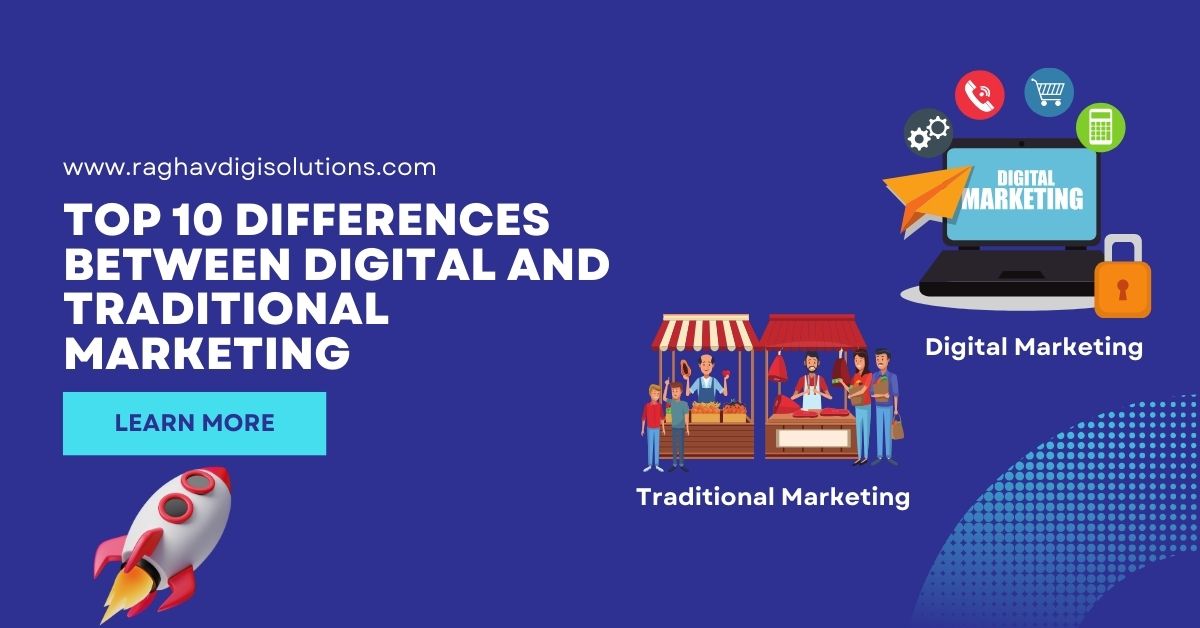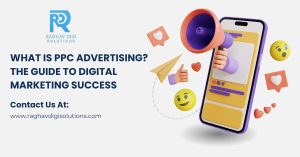Marketing is the backbone of every successful business. Over the decades, we have seen it evolve from newspaper ads and radio jingles to Google Ads, Instagram reels, and AI-driven personalization. While traditional marketing still holds importance in many sectors, digital marketing has become the dominant force due to its affordability, reach, and data-driven approach.
Understanding the Top 10 differences between digital and traditional marketing is no longer optional—it’s essential for entrepreneurs, marketers, and businesses aiming to thrive in 2025 and beyond. This article dives deep into the top 10 differences, offering updated insights, real-world examples, and actionable takeaways.
1. Cost and Budget Allocation
Digital Marketing:
Digital platforms allow businesses to start campaigns with budgets as low as $5 per day. Tools like Google Ads, Facebook Ads, and email automation platforms make marketing accessible to startups and SMEs. For instance, an Instagram ad campaign in India can start from ₹500 and reach thousands of users.
Traditional Marketing:
On the flip side, traditional methods like TV, radio, and newspaper ads require hefty investments. A 30-second television ad in India can cost between ₹2–5 lakhs during prime time. This puts it out of reach for smaller businesses.
Key Insight:
Digital marketing is cost-efficient and scalable, while traditional marketing demands large upfront budgets.
2. Audience Targeting and Segmentation
Digital Marketing:
The ability to micro-target audiences is digital marketing’s biggest strength. Marketers can filter by age, location, income, interests, or even recent search history. Platforms like Meta Ads Manager and Google Analytics provide granular audience insights.
Traditional Marketing:
Traditional methods like billboards or newspaper ads cast a wide net but lack precision. For example, a car dealership placing a newspaper ad cannot control whether the readers are actually interested in buying a car.
Key Insight:
Digital marketing = laser-focused targeting.
Traditional marketing = mass exposure, limited control.
3. Measurability and Analytics
Digital Marketing:
Every click, conversion, and impression is trackable in real-time. Tools like Google Analytics 4 (GA4), HubSpot, and SEMrush provide insights into campaign ROI. Businesses can instantly see which ads generate the most leads.
Traditional Marketing:
Measurement is vague. A company may run a billboard campaign but has no direct way to calculate conversions. Feedback is often delayed and based on estimates rather than hard data.
Key Insight:
Digital = Data-driven decision-making.
Traditional = Reliance on assumptions and indirect surveys.
4. Reach and Geographical Boundaries
Digital Marketing:
Digital campaigns can be global within minutes. A small business in Agra can target audiences in New York or London instantly. This borderless reach is especially beneficial for e-commerce and SaaS businesses.
Traditional Marketing:
Traditional methods are often geographically limited. Flyers, posters, and local TV ads reach specific regions but require massive investments to go national or international.
Key Insight:
Digital marketing offers limitless reach. Traditional is more localized.
5. Speed and Flexibility of Execution
Digital Marketing:
Campaigns can be launched within hours. Adjustments (budget, creative, copy) can be made instantly if performance is weak. This agility is unmatched.
Traditional Marketing:
Production of TV commercials, print ads, or hoardings takes weeks or months. Any change post-launch requires reprinting or re-shooting, leading to high costs.
Key Insight:
Digital = fast and adaptable.
Traditional = slow and rigid.
6. Content Format and Creativity
Digital Marketing:
Modern digital marketing embraces dynamic content formats—videos, infographics, reels, podcasts, blogs, webinars, and interactive ads. In 2025, short-form video platforms like Instagram Reels and YouTube Shorts dominate user engagement.
Traditional Marketing:
Formats remain limited to static ads like newspapers, TV spots, brochures, or radio jingles. While impactful, they cannot match the variety and interactivity digital provides.
Key Insight:
Digital = multi-format, interactive creativity.
Traditional = static, one-dimensional creativity.
7. Engagement and Customer Interaction
Digital Marketing:
Engagement is two-way. Brands can instantly interact with customers via comments, direct messages, chatbots, and social media communities. User-generated content further strengthens brand relationships.
Traditional Marketing:
Engagement is one-way. Customers passively consume TV, radio, or print ads without any direct interaction with the brand.
Key Insight:
Digital = conversations and communities.
Traditional = broadcast-only communication.
8. Feedback Loop and Adaptability
Digital Marketing:
Real-time feedback through reviews, ratings, and comments allows brands to pivot quickly. For example, if an ad is underperforming, marketers can A/B test instantly.
Traditional Marketing:
Feedback is delayed and often requires expensive surveys or focus groups. Campaign adjustments cannot be made mid-way.
Key Insight:
Digital = instant feedback, easy optimization.
Traditional = delayed feedback, costly changes.
9. Longevity and Shelf Life
Digital Marketing:
Content like blogs, YouTube videos, or SEO-optimized articles can drive traffic for years. A single viral post can continue generating leads long after the campaign ends.
Traditional Marketing:
Billboards, TV ads, and flyers have a short lifespan. Once removed or expired, the campaign impact disappears.
Key Insight:
Digital = evergreen potential.
Traditional = short-lived impact.
10. Credibility and Trustworthiness
Digital Marketing:
While widely accessible, digital ads sometimes suffer from low credibility due to spam and clickbait. However, influencer marketing and verified reviews help build trust.
Traditional Marketing:
Still perceived as more trustworthy and authoritative, especially by older generations. A newspaper ad or TV spot often feels more “serious” and credible.
Key Insight:
Traditional = trust and tangibility.
Digital = authenticity through social proof.
Bonus: The Hybrid Future of Marketing
The most successful brands in 2025 are not choosing between the two—they’re blending digital and traditional strategies. For example:
- A clothing brand runs Instagram ads (digital) but also sends physical catalogs (traditional).
- A healthcare provider invests in TV ads while nurturing leads through email marketing.
This integrated approach maximizes reach, credibility, and ROI.
Conclusion
The differences between digital and traditional marketing highlight two distinct yet complementary worlds.
- Digital marketing is cost-effective, measurable, and globally scalable.
- Traditional marketing is trustworthy, tangible, and impactful at the local level.
For businesses in 2025, the key isn’t choosing one over the other but knowing how and when to use both. By leveraging the precision of digital tools with the credibility of traditional methods, brands can create powerful, lasting impressions.
To Know More: Best Seo Services In Agra, Affordable Digital Marketing Company In Agra




